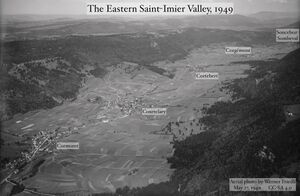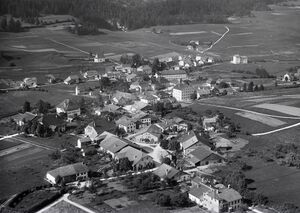Cortébert: Difference between revisions
Created page with "Cortébert is a village in the Vallon du St-Imier. Located in the middle of the valley, Cortébert was primarily an agricultural village. In November 1863 the watchmaking firm Raiguel, Juillard & Cie purchased Jean Weber's mill, located next to the old stone bridge over the Suze river. It was quickly demolished and replaced by a massive 2-story factory building. Still located in the town, the mill had 66 windows on the south side, mirrored on the north, to let i..." |
No edit summary |
||
| (4 intermediate revisions by the same user not shown) | |||
| Line 1: | Line 1: | ||
{| class=wikitable width=320px align=right | |||
!Cortébert | |||
|- | |||
|[[File:1949 ETH-BIB-Cormoret, Courtelary, Cortébert, Corgémont, Vallon-LBS H1-012040 small.jpg|center|300px]] | |||
|- | |||
|align=center|[[Jura triangle]] / [[Canton Berne]]<br>[[Bernese Jura]] / [[Vallon de Saint-Imier]] | |||
|- | |||
|align=center|[[Courtelary]] - '''Cortébert''' - [[Corgémont]] | |||
|} | |||
Cortébert is a village in the [[Vallon du St-Imier]]. | Cortébert is a village in the [[Vallon du St-Imier]]. | ||
Located in the middle of the valley, Cortébert was primarily an agricultural village. In November [[1863]] the watchmaking firm Raiguel, Juillard & Cie purchased Jean Weber's mill, located next to the old stone bridge over the Suze river. It was quickly demolished and replaced by a massive 2-story factory building. Still located in the town, the mill had 66 windows on the south side, mirrored on the north, to let in natural light. | Located in the middle of the valley, Cortébert was primarily an agricultural village. In November [[1863]] the watchmaking firm Raiguel, Juillard & Cie purchased Jean Weber's mill, located next to the old stone bridge over the Suze river. It was quickly demolished and replaced by a massive 2-story factory building. Still located in the town, the mill had 66 windows on the south side, mirrored on the north, to let in natural light. | ||
In [[1880]] the factory became known as the [[Fabrique d'ébauches de Cortébert]]. Around 1900 the water power was augmented by a steam boiler, though the water wheel continued in use. | |||
[[Category:Vallon | Shortly after the death of founder Emile Juillard the company took the name [[Cortébert Watch]]. Emile's sons continued the operation with their uncle Henri and the company flourished through the turn of the century. In [[1918]] the old water wheel was replaced by a 35 horsepower horizontal turbine that doubled the power of the hydraulic mill. | ||
[[File:1925 ETH-BIB-Cortébert aus 200 m-Inlandflüge-LBS MH01-004661 small.jpg|right|thumb|300px|Aerial view of Cortébert in 1925]] | |||
The Cortébert Watch Company survived the post-war recession and global depression of the 1920s and 1930s but the firm, which had primarily produced pocket watches, was not competitive through the 1950s. In [[1962]] the factory was taken over by [[Omega]] and the hydraulic turbine was silenced. | |||
[[Category:Vallon de Saint-Imier]] | |||
[[Category:Cortébert]] | [[Category:Cortébert]] | ||
Latest revision as of 13:05, 20 February 2024
| Cortébert |
|---|
 |
| Jura triangle / Canton Berne Bernese Jura / Vallon de Saint-Imier |
| Courtelary - Cortébert - Corgémont |
Cortébert is a village in the Vallon du St-Imier.
Located in the middle of the valley, Cortébert was primarily an agricultural village. In November 1863 the watchmaking firm Raiguel, Juillard & Cie purchased Jean Weber's mill, located next to the old stone bridge over the Suze river. It was quickly demolished and replaced by a massive 2-story factory building. Still located in the town, the mill had 66 windows on the south side, mirrored on the north, to let in natural light.
In 1880 the factory became known as the Fabrique d'ébauches de Cortébert. Around 1900 the water power was augmented by a steam boiler, though the water wheel continued in use.
Shortly after the death of founder Emile Juillard the company took the name Cortébert Watch. Emile's sons continued the operation with their uncle Henri and the company flourished through the turn of the century. In 1918 the old water wheel was replaced by a 35 horsepower horizontal turbine that doubled the power of the hydraulic mill.

The Cortébert Watch Company survived the post-war recession and global depression of the 1920s and 1930s but the firm, which had primarily produced pocket watches, was not competitive through the 1950s. In 1962 the factory was taken over by Omega and the hydraulic turbine was silenced.